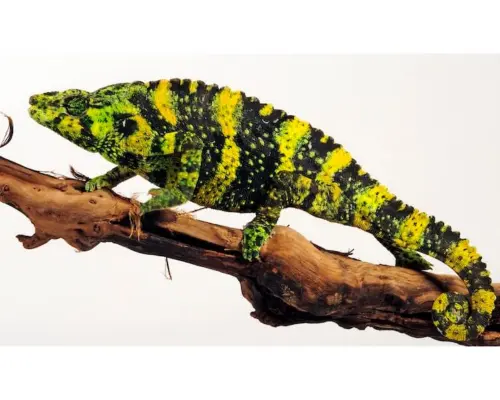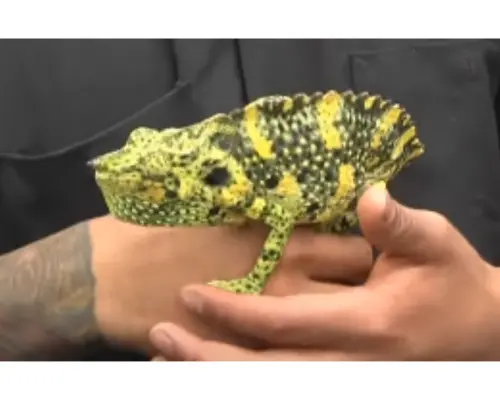There is a large and striking chameleon found in the mountainous areas of eastern Africa in the countries of Zimbabwe, Uganda, and South Africa. Growing to an adult length of 2 feet or more, it is instantly recognizable by its large size and bright yellow and green coloring, as well as the large occipital lobes and a single rostral horn. This horn, which gives them their nickname, “giant one-horned chameleon,” is often missing in captivity, as a result of accident or injury during importation.
A true Meller’s chameleon has eyes that spin independently, a long tongue that can shoot nearly the length of the animal’s body, a prehensile tail and feet that allow the animal to securely grip, and fused toes that allow it And of course it has the ability to change color. Males change colors to show off for potential mates and to intimidate the competition in order to get the attention of potential mates, but popular culture leads us to believe this is for camouflage.
The coloration of Meller’s chameleons undergoes a dramatic change when they fear or feel threatened. They become covered in black spots, and their green coloring becomes nearly black. If the perceived threat is still present, while swaying back and forth, melleri will bring its occipital lobes forward and begin to gape and hiss at the threat. It is a very impressive sight, but fortunately. In captivity, melleri are usually gentle giants, and while they do stress easily, they rarely threaten their keepers with such a display.
Healthy Food for mellers Chameleons
Meller’s are large chameleons that can eat a great deal, and it is important to provide them with a healthy and varied diet. In the wild, they consume a variety of insects, including grasshoppers, flies, moths and beetles. Some have even been known to consume small lizards and birds. You can feed pet Meller’s crickets, dubia roaches, silkworms, and praying mantises, to name just a few options. These large chameleons will also enjoy larger prey items and flying insects, too favorites of mine include mantids, dragonflies and butterflies.
Crickets and dubia roaches are the most popular prey items that are appropriate for Meller’s chameleons. The insects should be gut loaded, meaning they should be fed healthy greens, fruits and grains before being offered to your pet.
It is important to dust feeders with calcium because a lack of it can lead to secondary hyperparathyroidism and death. It’s a good idea to give a multivitamin supplement as well. It is important to use the correct amount of calcium and the correct number of vitamins in your diet. T said that you do not want to overdose your chameleon. The melleri don’t need as much supplementation as other lizard species if their feeders are properly gut loaded. It’s usually sufficient to have plain calcium a few times a week and vitamins like D3 once a month.


















